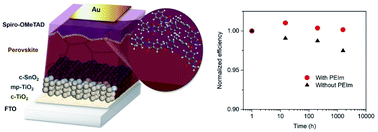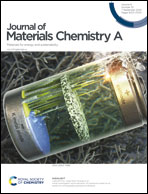Gradient band structure: high performance perovskite solar cells using poly(bisphenol A anhydride-co-1,3-phenylenediamine)†
Abstract
Surface passivation is a critical factor for improving the photovoltaic performance of perovskite solar cells. However, more robust principle investigations are required to build effective passivation strategies enabling high-performance perovskite solar cells. Here, it is demonstrated that a non-reactive organic polymer induces band-bending at the perovskite surface through a passivation effect, furthermore suppressing Pb0 formation at the perovskite surface. Consequently, the photovoltaic performance and stability of the perovskite solar cells can be improved. The key findings show that the polymer passivation layer can control the Fermi-level at the perovskite surface, which changes the band structure at the perovskite surface and affects carrier dynamics by suppressing non-radiative pathways. Moreover, the organic polymer can prevent degradation of the perovskite surface. By using the passivating layer, the open circuit voltage improves from 1.046 to 1.100 V, the photoconversion efficiency exceeds 21%, and the stability of the perovskite solar cells is substantially improved. The organic polymer poly(bisphenol A anhydride-co-1,3-phenylenediamine) (PEIm) was used to control the perovskite band structure, and this passivation mechanism is revealed here.



 Please wait while we load your content...
Please wait while we load your content...